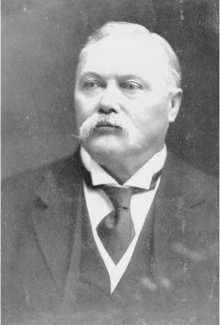John Hendry (industrialist)
John Hendry, (January 20, 1843 - July 17, 1916), created B. C. Mills, the first major lumber company in western Canada starting with his first mill in 1875.[1] He is a person of National Historic Significance in Canada.

Early life
Hendry was born in Belledune, New Brunswick to Scottish immigrants James and Margaret Hendry (née Wilson), and worked at the family mill before moving west permanently in 1872.
Lumber dominance

In 1876, Hendry and David McNair established Nanaimo Planing Mills.
Political foray
Hendry, was on New Westminster city council from 1879–80 and elected mayor in January 1889. He resigned in July because of a conflict of interest with him being involved with the New Westminster Southern Railway Company.
Legacy
Hendry's introduction of steam donkeys and railways were the model for the lumber industry of the 20th century.
In 1926, Hendry's daughter Aldyen, who was married to the Lieutenant Governor of British Columbia, Eric Hamber, donated some mill property to the Vancouver Park Board with the condition that it be named after her father. It is still known as John Hendry Park.[2][3]
See also
References
- "John Hendry". Dictionary of Canadian Biography (online ed.). University of Toronto Press. 1979–2016.
- "City of Vancouver". Archived from the original on 2014-07-31. Retrieved 2013-01-28.
- Vancouver Olympic Host City
External links
Morton, Jamie (1998). "Jenkins, John". In Cook, Ramsay; Hamelin, Jean (eds.). Dictionary of Canadian Biography. XIV (1911–1920) (online ed.). University of Toronto Press.